Bright yellow birds at your feeder are likely to grab your attention. They stand out against the background of any summer or winter scenery and bring cheeriness to your garden. If you need help identifying a backyard visitor, check out these 14 types of yellow birds, including pictures, a description of each, and their location. Most birds on the list are from North America, but you can find some of these species around the world. Let’s dive in!

Yellow Warbler

The most widespread warbler species in the Americas is the yellow warbler.
©Agami Photo Agency/Shutterstock.com
The yellow warbler is a New World warbler and the most widespread warbler species in the Americas. They completely embody what it means to be a yellow bird, with their buttery yellow plumage combined with sweet, whistling tunes during summer. Males also feature chestnut streaking on their breasts and black streaks on their wings. Yellow warblers breed in Canada and most of the United States and winter in Mexico, Central America, and Northern South America. These birds eat insects and don’t visit backyard feeders, but you can find them in thickets and regrowing habitats along streams.
American Goldfinch
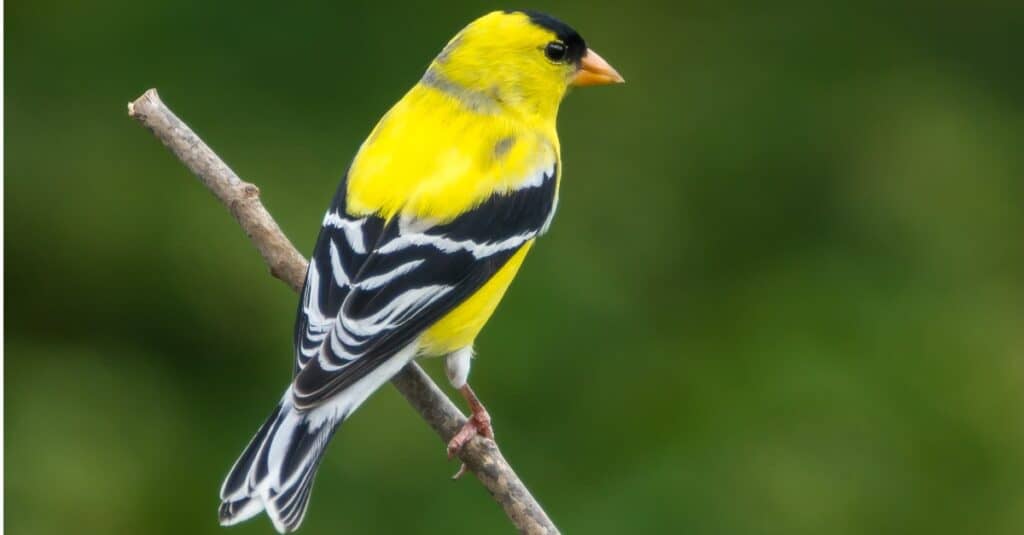
The American goldfinch averages around five inches in length.
©iStock.com/impr2003
We can’t have a list of yellow birds without mentioning the American goldfinch. These small North American finches undergo complete molts, where males are vibrant yellow during summer and olive in winter. They also feature black caps and black wings with white markings. And females are dull yellow-brown. Populations in the northern United States stay in their environments year-round. But those that breed in southern Canada migrate to the southern United States and Mexico for winter. You can find this bird in weedy fields, open floodplains, and overgrown areas.
Western Yellow Wagtail
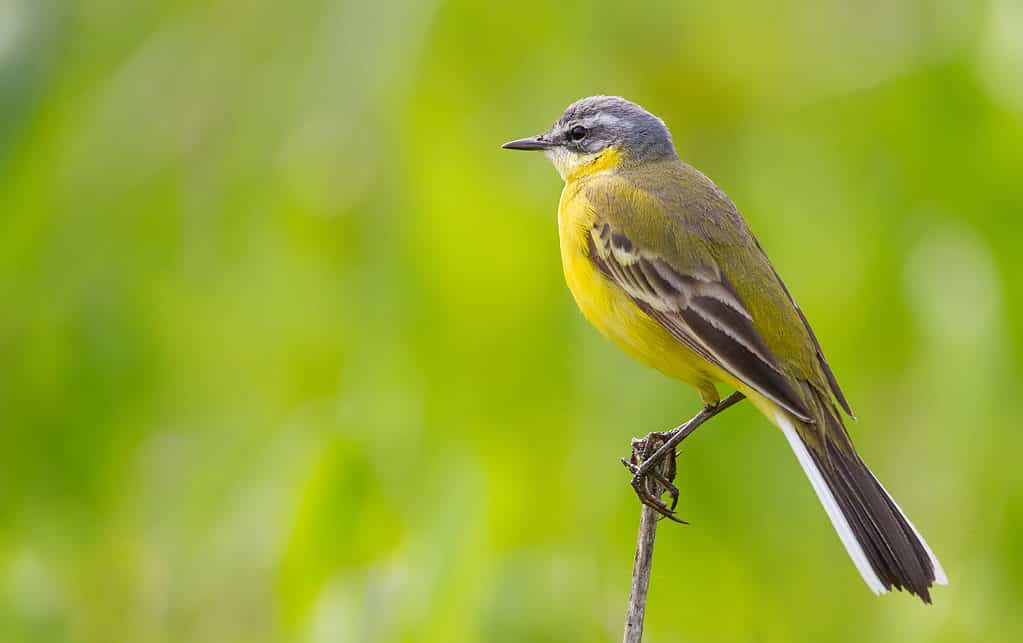
Consistent with their name, western yellow wagtails have wagging tails.
©Yuriy Balagula/Shutterstock.com
The western yellow wagtail is a small passerine native to Europe, Asia, and Africa. They are slender birds with long, wagging tails, and their plumage consists of olive above and yellow below. And their head color varies by subspecies. These birds breed across Europe and western Asia and migrate south to Africa and South Asia during winter. The wagtail favors wet meadows, muddy lakeshores, and marshland.
Western Tanager

Despite the name, western tanagers are actually cardinals.
©JamesChen/Shutterstock.com
The western tanager is a medium-sized flame-colored American songbird. While its name says tanager, this species is actually in the cardinal family, even though it resembles the tanager species. Adult males have bright red faces, yellow napes, shoulders, and rumps, and black backs, wings, and tails. And females have yellow heads, olive backs, and dark wings and tails. Western tanagers breed in the western United States and Canada and winters in Mexico and Central America. You can find them in coniferous woodlands and aspen forests.
Prothonotary Warbler
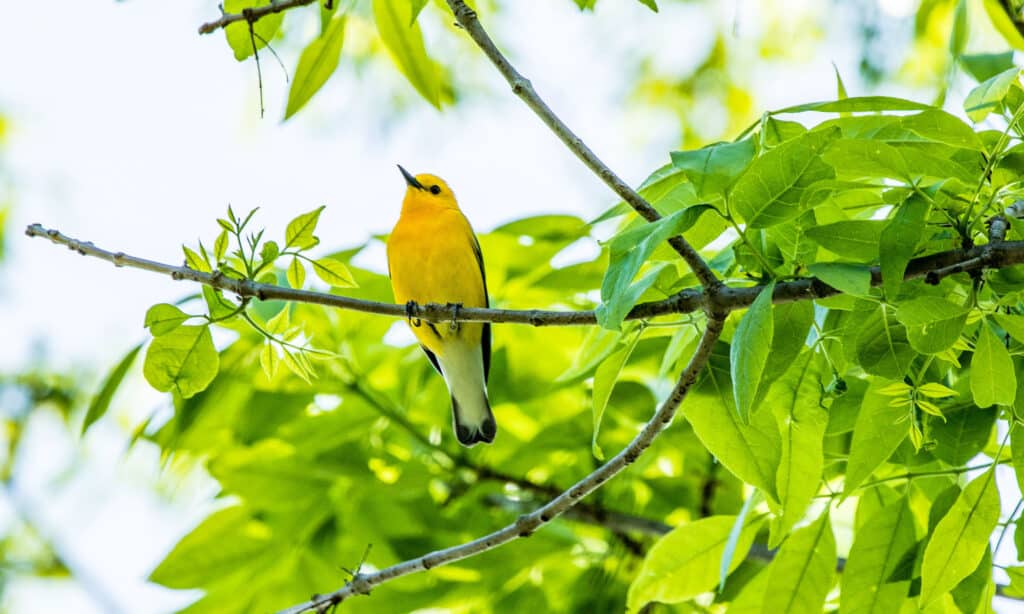
While they are from the New World warbler family, prothonotary warblers belong to their own genus.
©Mark C. Morris/Shutterstock.com
If you live in the southeastern United States, you can witness the prothonotary warbler as it flits through its dim forest habitat. They are small songbirds from the New World warbler family and the only one of their genus. These birds feature orange-yellow heads, yellow underparts, olive backs, and bluish-gray wings and tails. Females are similar in appearance, but they have dull yellow heads. The prothonotary warbler breeds in the southeast and winters in Mexico, Central America, and the northern tip of South America. And their preferred habitats include flooded bottomland forests and wooded swamps.
Eurasian Gold Oriole

Though the female Eurasian Golden Oriole isn’t terribly colorful, the male is bright yellow with black markings.
©iStock.com/phototrip
The Eurasian gold oriole is an Old World passerine in the northern hemisphere. They have a significant population with an extensive range, breeding in Europe and the Palearctic and wintering in central and southern Africa. They inhabit a wide range of habitats, including forests, plantations, orchards, and gardens. Males feature striking contrast with bright yellow bodies and heads, black wings and tails, and small eye masks. Females are a drab green color above and whitish below.
Prairie Warbler
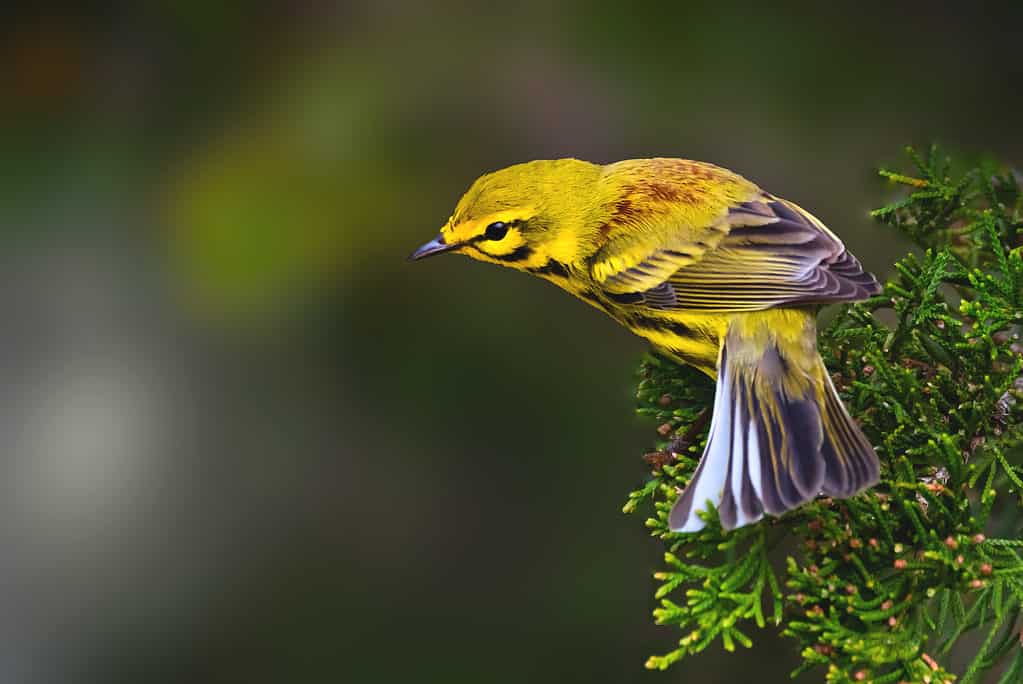
With chestnut-colored backs, black streaks, and bright yellow throughout, prairie warblers are a sight.
©Jay Gao/Shutterstock.com
Contrary to its name, the prairie warbler is not a resident of prairies. These small songbirds inhabit scrubby second-growth forests and overgrown pastures. They breed in the southeastern United States, migrate through the Gulf of Mexico, and winter in the Caribbean. There is also a year-round population in southern Florida. The prairie warbler has complex plumage, with bright yellow undersides, heavy dark streaks, black eye lines, and chestnut patches on their backs.
Yellow-Headed Blackbird

Like their name implies, yellow-headed blackbirds are black birds with yellow plumage on their heads.
©iStock.com/Nancy Strohm
Its name sums it up just right, yellow-headed blackbirds are medium-sized black birds with golden heads. Males feature bright yellow heads and chests and black bodies with white patches on their wings. Females have brown plumage with dull yellow heads. They spend their summers in central and western Canada and the United States and winter in the Southwest and Mexico. The best places to see these blackbirds are in wetlands in prairies, mountain meadows, and marshes.
Cape Weaver

Male cape weavers have yellow heads and orange faces.
©Rich Lindie/Shutterstock.com
Cape weavers are stocky passerines native to Southern Africa. This species is endemic to South Africa, Eswatini, and Lesotho, where they live in open grasslands, coastal thickets, and farmland. Breeding males have yellow heads and underparts, orange faces, and olive-brown upper parts. Females have olive-yellow heads and breasts with pale yellow undersides. This species is relatively social and can be found in flocks outside of the breeding season, and they form communal roosts throughout the year.
Eastern and Western Meadowlark

Western meadowlarks are nearly identical in appearance to eastern meadowlarks.
©iStock.com/Gary Gray
The meadowlarks are a group of grassland birds native to the Americas, primarily South America. You can find eastern meadowlarks in the eastern United States to northern South America, and the western meadowlark resides in the west and central US. They both inhabit grasslands, prairies, pastures, and abandoned fields. The eastern species has yellow underparts with a black “V” on their chests and brown upperparts with black streaks. The western species look almost identical, except their plumage is paler with thinner black streaking.
Yellow-Throated Vireo

As one of the most colorful members of the vireo family, yellow-throated vireos have yellow throats, white bellies, and olive heads.
©JoshuaGoddard/Shutterstock.com
The yellow-throated vireo is a small songbird native to North and South America. They are one of the most colorful members in the vireo family and feature yellow throats, olive heads, white bellies, and brown-grey backs and wings. They also have dark irises with bright yellow rings around them, looking like spectacles. You can find this species in the eastern half of the United States during summer, in Mexico, Central America, and in the northern tip of South America during winter.
Golden Pheasant
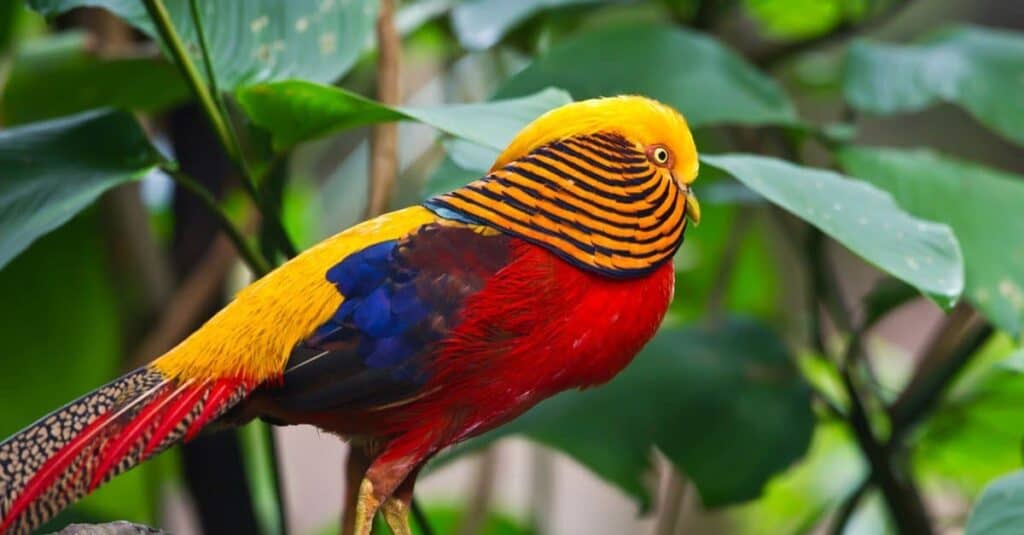
With a mix of red, blue, orange, green, and yellow, golden pheasants are vastly colorful birds.
©mooinblack/Shutterstock.com
Also known as the Chinese pheasant, these game birds are native to mountainous forests in western China. However, feral populations exist in many countries, including the United States, the United Kingdom, Canada, Mexico, and several others. You will often find them in dense forests, but they forage in flocks near human habitations during winter. Golden pheasants are brightly colored, featuring a mixture of red, blue, green, orange, and yellow. They get their name from the golden-yellow crests atop their heads.
Western Kingbird
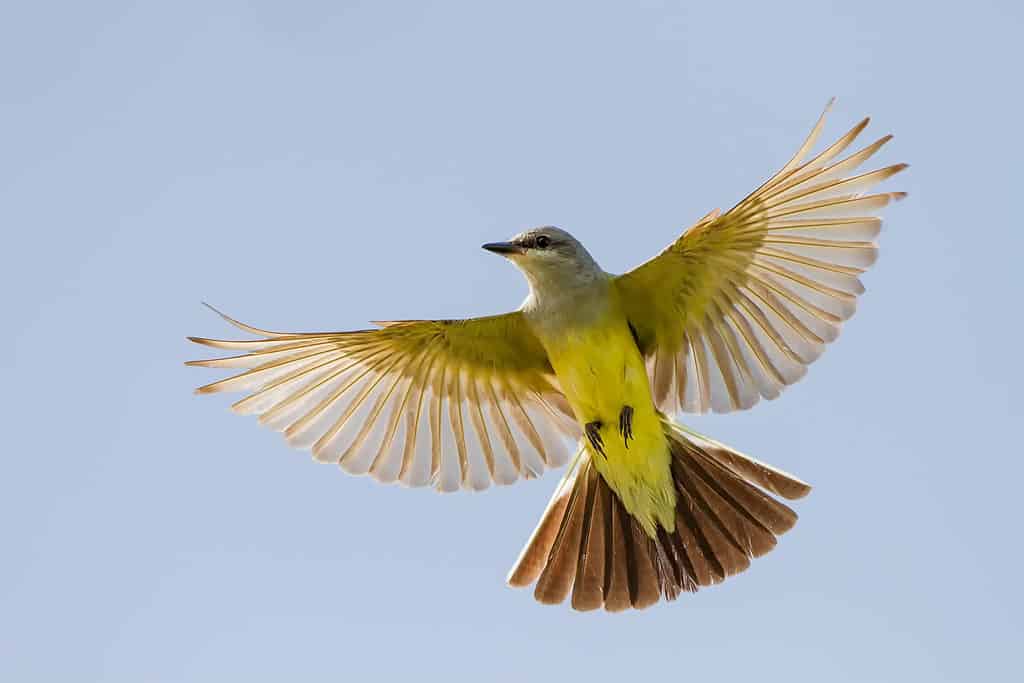
While most of the western kingbird plumage is gray and brown, their underbellies are a bright yellow.
©Wildvet/Shutterstock.com
Western kingbirds are large tyrant flycatchers featuring more subtle yellow plumage than others on this list. They have grey heads, white throats and chests, brown wings and tails, and lemon-yellow bellies. This species breeds in the western half of the United States and winters along the coasts of Mexico, Central America, and southern Florida. Their preferred habitats include grasslands, desert shrubs, pastures, fields, and savannas.
Common Yellowthroat
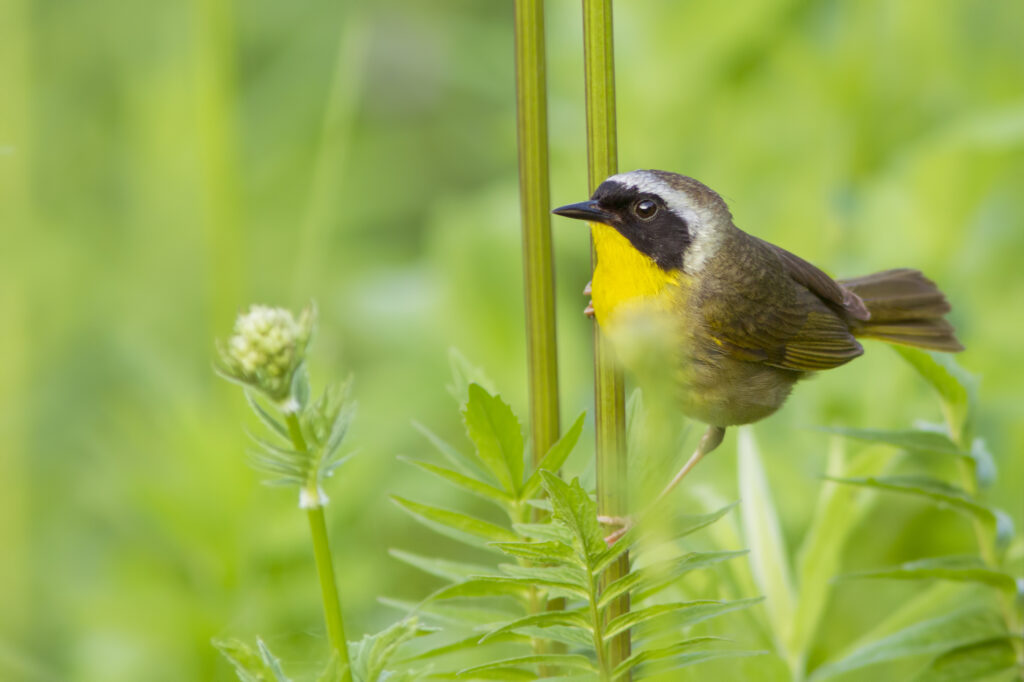
The common yellowthroat has a distinctive black band across its eyes.
©Mircea Costina/Shutterstock.com
Featuring a distinctive black band across its eyes, the common yellowthroat is unmistakable in its wetland habitat. These New World warblers, also known as the yellow bandits, have bright yellow plumage on their throats and chests. They also have white lines on their heads and olive-brown upper parts. They breed across Canada and the United States and winter in Mexico and Central America. And some populations live year-round in California and the southeast. Look for them in many habitats, such as wetlands, prairies, forests, and thickets.
Dickcissel
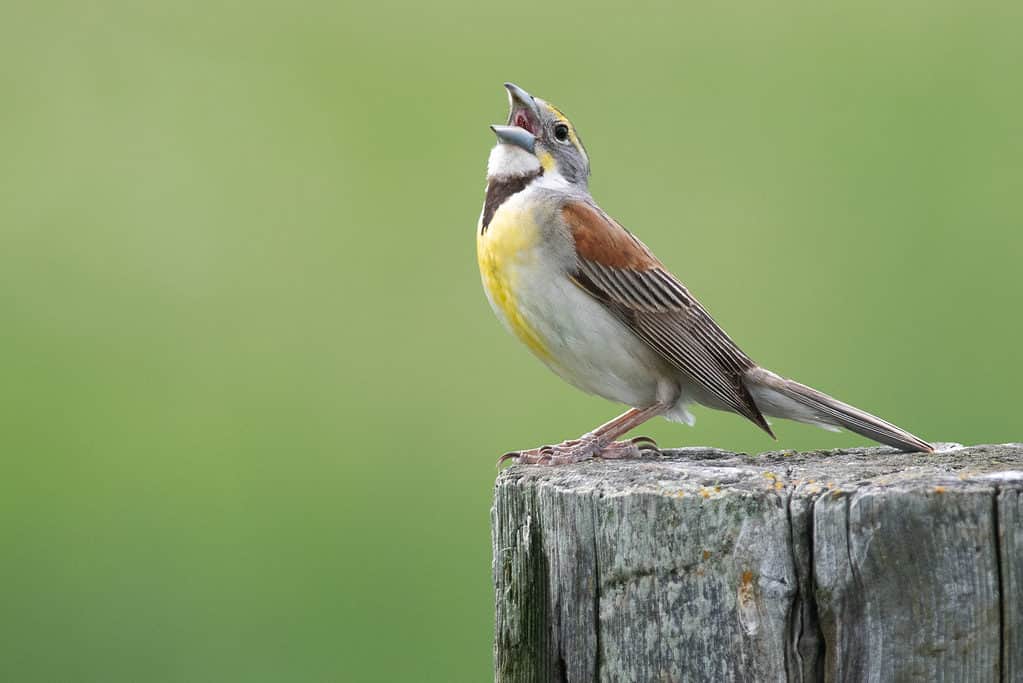
With just a yellow chest and head, dickcissels have varied plumage on their bodies.
©Amanda Guercio/Shutterstock.com
The dickcissel is a tiny, chunky bunting native to North American grasslands. They have large, thick bills and short tails, with yellow faces and chests. Their heads and backs are brown and gray, with reddish-brown shoulders. And their throats have a distinctive black “V” shape. You can find them in prairies and restored grasslands in the central US during the summer and in Mexico, Central America, and northern South America during winter.
Summary of 15 Types of Yellow Birds
Let’s take another look at these yellow birds in an overview:
| Number | Bird Name | Accessory Colors | Habitat | Locations |
|---|---|---|---|---|
| 1 | Yellow Warbler | Chestnut and black | Thickets and regrowth areas along streams | North, Central, & South America |
| 2 | American Goldfinch | Black, white | Weedy fields, open floodplains, overgrown areas | N. America |
| 3 | Western Yellow Wagtail | Olive | Wet meadows, muddy lakeshores, marshlands | Europe, Western & South Asia, and N. Africa |
| 4 | Western Tanager | Black or olive | Coniferous woodlands, aspen forests | Western US, Canada, Mexico, and C. America |
| 5 | Prothonotary Warbler | Orange, olive, blue- gray | Flooded bottomlands, forests, wooded swamps | Wetlands, prairies, forests, thickets |
| 6 | Eurasian Gold Oriole | Black or green and white | Forests, orchards, plantations, gardens | Europe, Palearctic, and Africa |
| 7 | Prairie Warbler | Dark streaks, chestnut patches | Scrubby second-growth forests, overgrown pastures | SE US, Caribbean |
| 8 | Yellow-headed Blackbird | Black, white | Wetlands in prairies, mountain meadows, marshes | C. & W. Canada, SW US, Mexico |
| 9 | Cape Weaver | Orange, olive | Open grasslands, coastal thickets, farmlands | Southern Africa |
| 10 | Eastern and Western Meadowlark | Black, brown | Grasslands, prairies, pastures, fields | The Americas |
| 11 | Yellow-throated Vireo | Olive, white, brown-gray | Orange, olive, blue-gray | N. & C. Americas |
| 12 | Golden Pheasant | Red, blue, green, orange, gold | Mountainous forests | Native to China; feral in other countries |
| 13 | Western Kingbird | Grey, white, brown | Grasslands, desert shrubs, pastures, fields, savannas | W. US, Mexico, C. America, S. Florida |
| 14 | Common Yellowthroat | Black, brown, white | Wetlands, prairies, forest, thickets | Canada, US, Mexico, C. America |
| 15 | Dickcissel | Brown, gray, reddish-brown | Prairies, restored grasslands | Central US, Mexico, C. America, Northern S. America |
The photo featured at the top of this post is © Jay Gao/Shutterstock.com
Sources
- IUCN Red List, Available here: https://www.iucnredlist.org/
- Missouri Department of Conservation, Available here: https://education.mdc.mo.gov/discover-nature/field-guide/yellow-warbler
- Missouri Department of Conservation, Available here: https://education.mdc.mo.gov/discover-nature/field-guide/scarlet-tanager#:~:text=But%20DNA%20testing%20showed%20that,birds%20in%20the%20tanager%20family
Thank you for reading! Have some feedback for us? Contact the AZ Animals editorial team.







